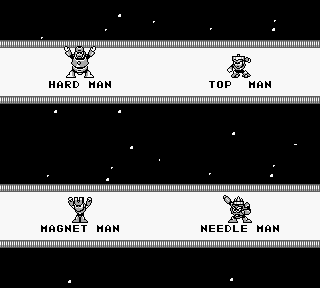Mega Man II
| Mega Man II |
|---|
|
Also known as: Rockman World 2 (JP), Rockman II (CN)
|
Mega Man II is, as you may have guessed, the followup to the first Game Boy entry. It was made in five months by a completely different development team that knew little about the series, and it shows.
It's also one of the few Game Boy titles to receive an official Chinese release.
Contents
Sub-Pages
| Prerelease Info |
Robot Master Select #2
Set memory address CF66 to 04-07 on the Robot Master select screen and you'll be able to choose the Mega Man 3 Robot Masters. Interestingly, they have animations and text strings that aren't used anywhere else in the game. They were clearly meant to be used, but they aren't. After beating the Robot Master, you'll be thrown back to the stage select.
Their stage select icons can be found below.
Unused Music
Seems to be an alternate version of the ending theme.
Unused Borders
| Mockup | In-Game |
|---|---|
 |
 |
When checking the HUD graphics code it is possible to notice that it uses two different white tiles, the tiles $70 and $5D, however when editing the graphics of the $5D tile we can see that originally the HUD would have borders, something very similar to an earlier version of the first Game Boy game.
Unused Level Tiles
Air Man
There are some tiles of clouds that are unused in the stage.
Crash Man
Two unused tiles. One was probably meant to be used for clouds like in the NES version of the stage; the final version uses mountains instead. The other appears to be a connector for two black orb tiles.
Metal Man
The gears in Metal Man's stage are supposed to be animated, like in the NES version. The two gear frames are loaded into memory, but the developers never got the actual animation part of this done.
A tile at the bottom of the mats that is unused.
Wood Man
Two tiles possibly from an early version of the floor graphic or from an unused platform on stage.
Some tiles of tree leaves from the background that are unused in the stage.
Needle Man
Some background and foreground tiles, as well as some spikes. The long vertical background piece (the one with the hole in it) is used in the NES version of Needle Man's stage for the inside sections. The tiles at the bottom are used in the NES version as floor tiles.
Magnet Man
More generic foreground and background tiles. The first tile is based on the tiles used in the NES version for the inside sections of Magnet Man's stage. They were replaced by the more eye-pleasing striped tiles. The next two tiles are intended for the outside background, but aren't used. The last tile should have been placed above the magnets (similar tiles appear in the NES version, and there's even space for them in the Game Boy version), but they're not.
Hard Man
A rocky platform, clearly modeled after the NES version. The final game's Hard Man level is decidedly industrial in theme, though it may have changed during development.
Just an unused cloud tile.
Top Man
The NES Top Man stage had spikes, so it would make sense for them to appear in the Game Boy version, but nope. The other two tiles are background tiles that never have a chance to get used. They're completely unique to the Game Boy version, too.
An unused background tile from Tama's room.
Wily Castle
Unused tiles for the computer-thing seen in the second room of Wily Castle's opening cutscene. The final game reuses graphics from the teleporters instead.
These darkened background wall graphics are likely used as a shadow for the teleporter room's platforms, but they're not used for some reason.
Time Warp
Short and long pipes. Their actual function is unknown. One part of them is actually used in-game, but it's so ill-fitting that it might be a programming error.
Unused Graphics
Unused graphics not related to the actual levels.
Mega Man
| Unused | Used |
|---|---|
While tiles for Mega Man inching forward are present as usual, only one of them is actually used in-game, resulting in one of his legs inexplicably shrinking when he first moves forward.
| Early | Final |
|---|---|
This early buster shot based on the NES sprite would get replaced with its equivalent from the first Game Boy entry.
Bosses
Crash Man
| Early | Final |
|---|---|
A poorly-made early walking frame for Crash Man. Luckily, it was replaced with a much better sprite.
Metal Man
| Early | Final |
|---|---|
An early, single-framed version of the Metal Blade can be found in Metal Man's sprite set. This 16×16 sprite seems more accurate to the NES version than the final sprite, which uses two 8×8 tiles that are flipped vertically and horizontally for each frame.
Needle Man
An unused firing frame for Needle Man. While an equivalent frame is used in Mega Man 3, and should have been used here, the game instead erroneously alternates between the first firing frame and the standing frame when Needle Man shoots his Needle Cannon.
| Unused | Used |
|---|---|
And an unused tile for the needles themselves also exists. This tile was again, used in Mega Man 3, but for some inexplicable reason, this game opts to use a different, horizontally facing needle sprite, despite the fact that Needle Man still only fires them diagonally downwards.
Magnet Man
An unused frame from Magnet Man's intro animation. Although this is used in Mega Man 3, here his animation is only two sprites, the same as every other Robot Master in the game.
Quint Intro
![]()
An unused intro animation for Quint. He just stays still in the final version.
Enemies
Giant Springer
![]()
A diagonal sprite for the missiles Giant Springers shoot. A different diagonal sprite is used for said missiles in Mega Man 3, but not here for whatever reason.
Metall
| Early | Final |
|---|---|
Leftovers from a slightly off-model early version of the Metall enemy are part of the sprite set for Hard Man's stage. They were later updated to match the NES version of Mega Man 3. No early version of their hard hat seems to exist.
Peterchy
| Unused | Used |
|---|---|
An unused sprite of Peterchy on both legs with its eye open. Its eye is closed in the used sprite. (Also note the different shading.)
Petit Goblin
| Early | Final |
|---|---|
Some kind of face thing. This appears in the Air Man stage's object set, possibly being an early version of the Petit Goblin.
Pipi
| Early | Final |
|---|---|
The hilarious-looking early Pipi is part of Wood Man's sprite set. These enemies appear in Wood Man's stage in the NES game but not in the Game Boy version, so their art was never updated.
| Early | Final |
|---|---|
The Pipi egg is a dinky 8×8 sprite in the Wood Man sprite set.
| Early | Final |
|---|---|
The Copipis that hatch from the egg have only one frame of animation in the Wood Man set.
Fonts
![]()
In the font graphics used for the weapons menu are some arrows that never get used.
![]()
A font stored near the font used in the credits. The actual credits use a different font style, with this shaded one resembling the Stage Start text when selecting a robot master. Also, the unused arrows make a reappearance.
![]()
An unused font that goes from 0 to F. Used to pad out unused parts of graphics banks. This game has the same graphics for the same padding purposes, once again unused there.
![]()
A number font that's used... in an entirely different game for the score display. Since the two games share staff and some code, it may be a leftover or a stray shared asset.
![]()
Near the select stage graphics is a small unused arrow of unknown purpose. Pointy.
Others
Earth
| Full | In-Game |
|---|---|
 |
The Earth graphic is slightly larger than it appears in-game - 16 pixels are cut off from the bottom.
Explosions
| Unused | Used |
|---|---|
 |
 |
While there are three explosion effects used throughout the game, stored alongside them in the sprite set is an unused fourth one.
Stage Select Robot Masters
| Early | Final |
|---|---|
 |
 |
Early versions of the Robot Masters appear in the ROM.
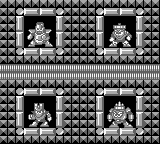
The early graphics actually use the background palette. They were probably used in a stage select like the one in Mega Man: Dr. Wily's Revenge.
The Mega Man 3 robot masters also have full intro animations. A demonstration can be found in the video above.
Wily Shuttle
| Unused | Used |
|---|---|
A number of different-sized images for Dr. Wily's spaceship.
Unused Damage Values
Modifying the game to have all weapons earlier than usual results in some interesting damage data that goes otherwise unused:
| Weapon Damage Data | ||||||||||
|---|---|---|---|---|---|---|---|---|---|---|
| Boss | Mega Buster | Metal Blade | Air Shooter | Crash Bomber | Leaf Shield | Needle Cannon | Magnet Missile | Hard Knuckle | Top Spin | Sakugarne |
| Crash Man | 01 | 00 | 02 | 00 | 00 | 00 | 00 | 00 | 00 | 00 |
| Metal Man | 01 | 0A | 00 | 05 | 00 | 00 | 00 | 00 | 00 | 00 |
| Wood Man | 01 | 05 | 01 | 02 | 00 | 00 | 00 | 00 | 00 | 00 |
| Air Man | 01 | 00 | 00 | 00 | 07 | 00 | 00 | 00 | 00 | 00 |
| Top Man | 01 | 00 | 01 | 00 | 00 | 02 | 01 | 04 | 00 | 02 |
| Needle Man | 01 | 00 | 03 | 01 | 00 | 00 | 01 | 00 | 05 | 02 |
| Magnet Man | 01 | 02 | 00 | 01 | 00 | 03 | 03 | 02 | 01 | 02 |
| Hard Man | 01 | 01 | 00 | 01 | 00 | 00 | 04 | 03 | 00 | 02 |
| Quint | 01 | 02 | 02 | 04 | 02 | 02 | 02 | 05 | 02 | 00 |
| Wily Machine II 1st | 01 | 00 | 00 | 00 | 00 | 00 | 00 | 00 | 00 | 00 |
| Wily Machine II 2nd | 01 | 00 | 00 | 00 | 00 | 00 | 00 | 00 | 00 | 02 |
| Wily Machine II 3th | 01 | 00 | 00 | 00 | 00 | 00 | 00 | 00 | 00 | 02 |
Notes:
- Weapons obtained by the Mega Man 3 Robot Masters and Quint do not damage the Mega Man 2 Robot Masters, instead ricocheting off of them as they appear to be invulnerable.
- Metal Man is once again hilariously weak to his own weapon, taking 10 points of damage.
- Hard Man and Magnet Man take 3 damage from their own weapons; A similar mechanic is present in the original Mega Man 3. Weirdly, Needle Man and Top Man in this game don't share this hidden stat.
- Sakugarne damages the Mega Man 3 Robot Masters for 2 damage each.
Regional Differences
Title Screen
| Japan | US/China |
|---|---|

|

|
As usual, the title screen was modified for the USA release. However this also included bumping the copyright date, and updating the copyright info to include Capcom USA. The EU version mostly takes after the USA version, but alters the licensing text to say "Licensed To Nintendo".
Despite being released four years later, the Chinese release simply uses the USA ROM untouched from its original release, despite the added Chinese name on the label claiming the game's name as "Rockman II", as well as the already updated EU release being present.
Top Man's Stage
| Japan/US/China | Europe |
|---|---|
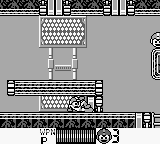 |
 |
One block was removed from this sliding tunnel. In the Japanese and American versions Mega Man would reach the end of the tunnel and stop moving but remain in his sliding animation, which looked rather silly.
Needle Man's Stage
| Japan/US/China | Europe |
|---|---|
 |
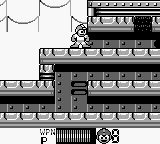 |
The platform at the top of this screen was lengthened to keep the player from jumping on top.
Room Before Final Boss
| Japan/US/China | Europe |
|---|---|
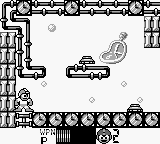 |
 |
The platform with a second Scworm generator was removed, replaced with a large background... bubble? Orb? Planet? Round thing.
End Credits
| Japan/US/China | Europe |
|---|---|
 |
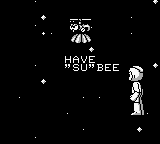 |
The Have "Su" Bee's name had its spelling corrected. The correct spelling actually already exists in the other versions of the game, but the name ends up getting cut off in-game due to it being too long.
References
- Pages missing developer references
- Games developed by Thinking Rabbit
- Pages missing publisher references
- Games published by Capcom
- Games published by Nintendo
- Game Boy games
- Pages missing date references
- Games released in 1991
- Games released in December
- Games released on December 20
- Games with unused graphics
- Games with unused music
- Games with regional differences
- Mega Man series
Cleanup > Pages missing date references
Cleanup > Pages missing developer references
Cleanup > Pages missing publisher references
Games > Games by content > Games with regional differences
Games > Games by content > Games with unused graphics
Games > Games by content > Games with unused music
Games > Games by developer > Games developed by Thinking Rabbit
Games > Games by platform
Games > Games by publisher > Games published by Capcom
Games > Games by publisher > Games published by Nintendo
Games > Games by release date > Games released in 1991
Games > Games by release date > Games released in December
Games > Games by release date > Games released in December > Games released on December 20
Games > Games by series > Mega Man series
The Cutting Room Floor > Unimportant Awards > Game Boy games
